On the Influence of the Soil and Groundwater to the Subsidence of Houses in Van Quan, Hanoi
The area of Van Quan, Hanoi before 2004 was the rice field. Nearby, Ha Dinh water plant
has well-drilled underground water for residential activities. Van Quan's new urban area after being
formed has detected many subsidences. The objective of this study is to assess the main causes of
the subsidence of the houses, based on groundwater and soil. This paper applied the regression
method to study the effect of soil and groundwater on the residential constructions in Van Quan
urban area, Hanoi. Subsidence monitoring was carried out for 4 consecutive years, from 2005 to
2009, including over 500 subsidence monitoring points with high-precision Ni007 and INVAR
gauges. A groundwater observation well is 30 meters deep at the site of the settlement. The results
show a small effect of groundwater on subsidence. The characteristics of the young sediment area
and the soil consolidation process are the main causes leading to serious subsidence in residential
constructions in Van Quan urban area. This paper provides a different perspective on the impact of
groundwater on the subsidence of residential structures within approximately 100 ha.
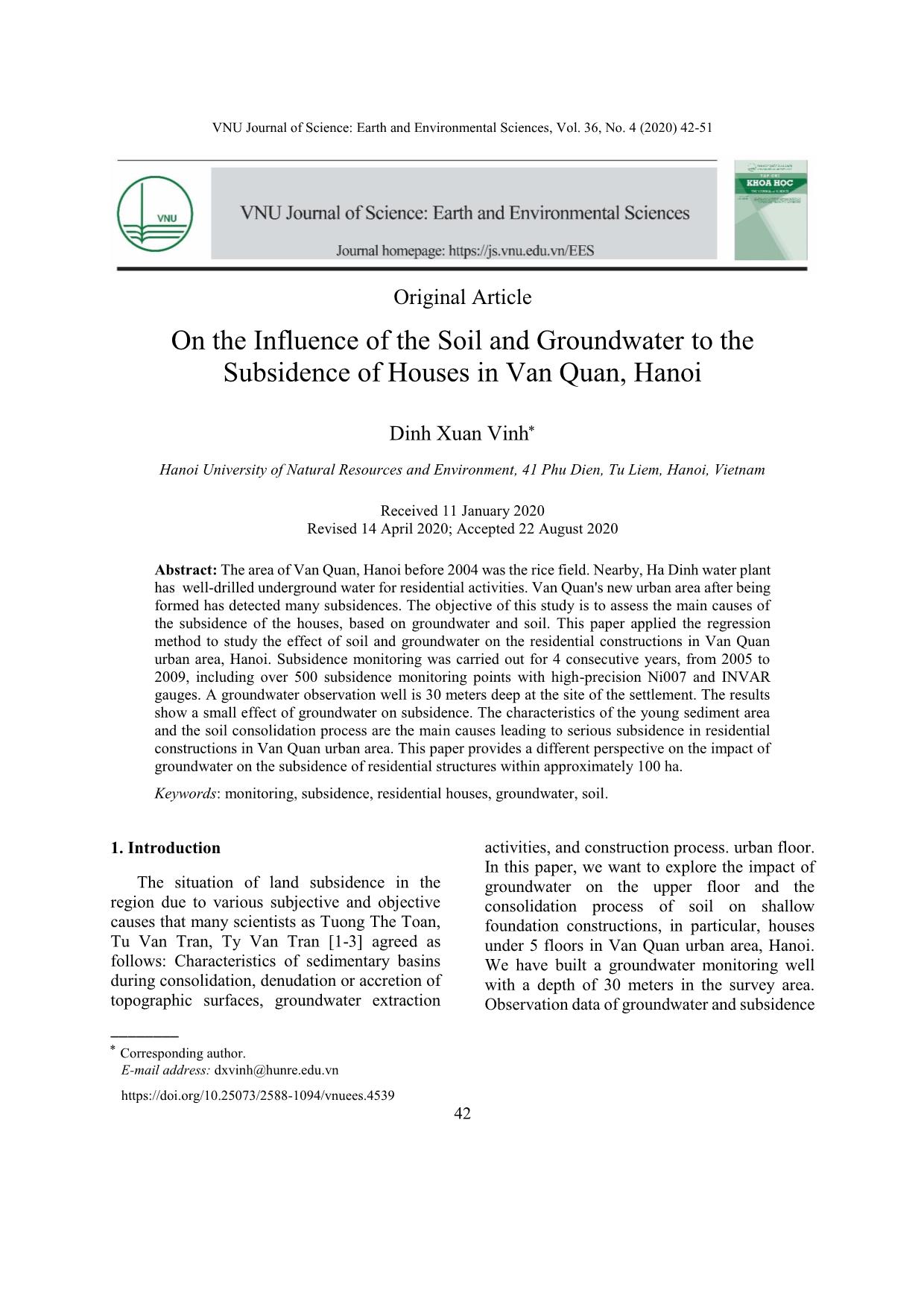
Trang 1
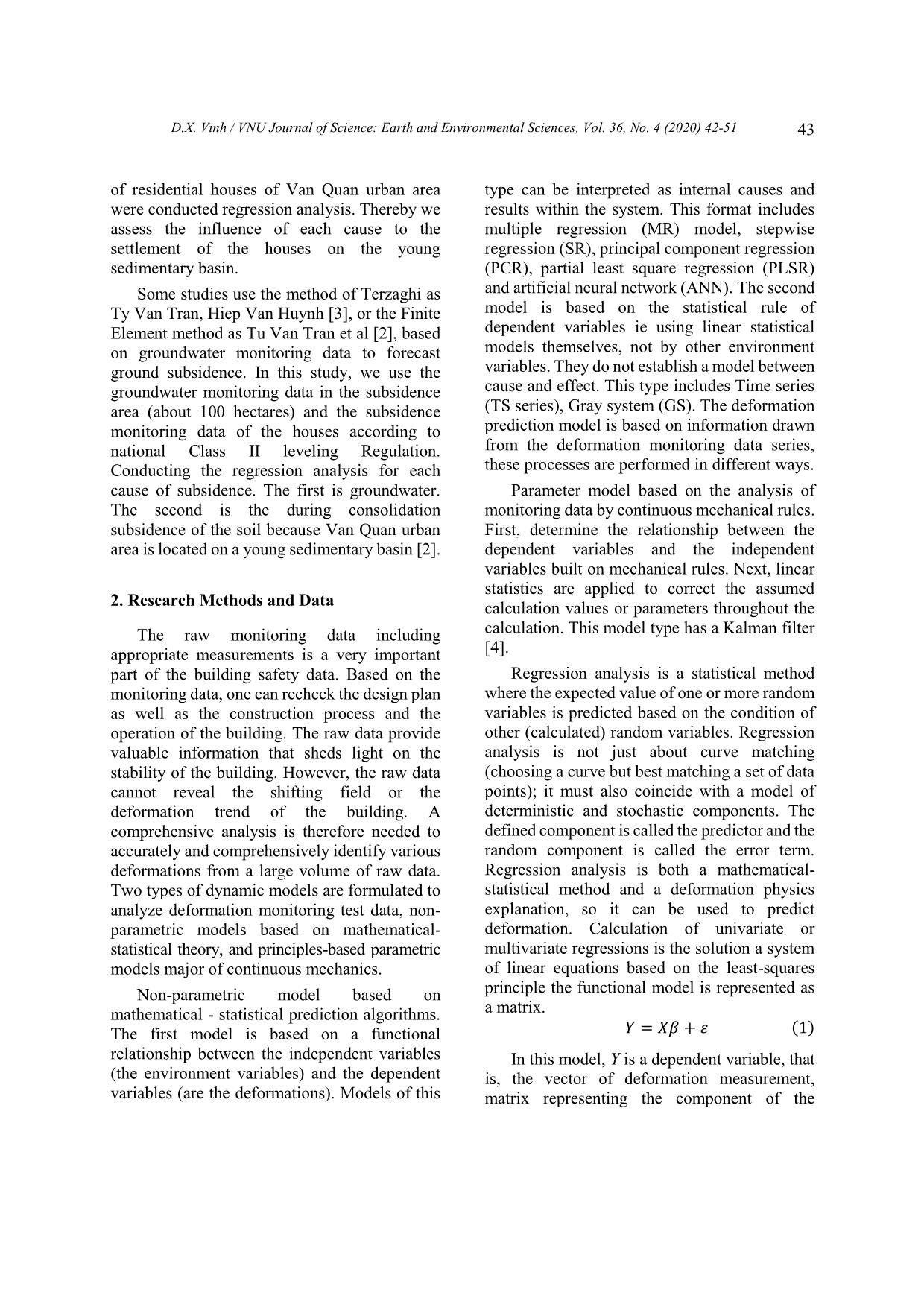
Trang 2
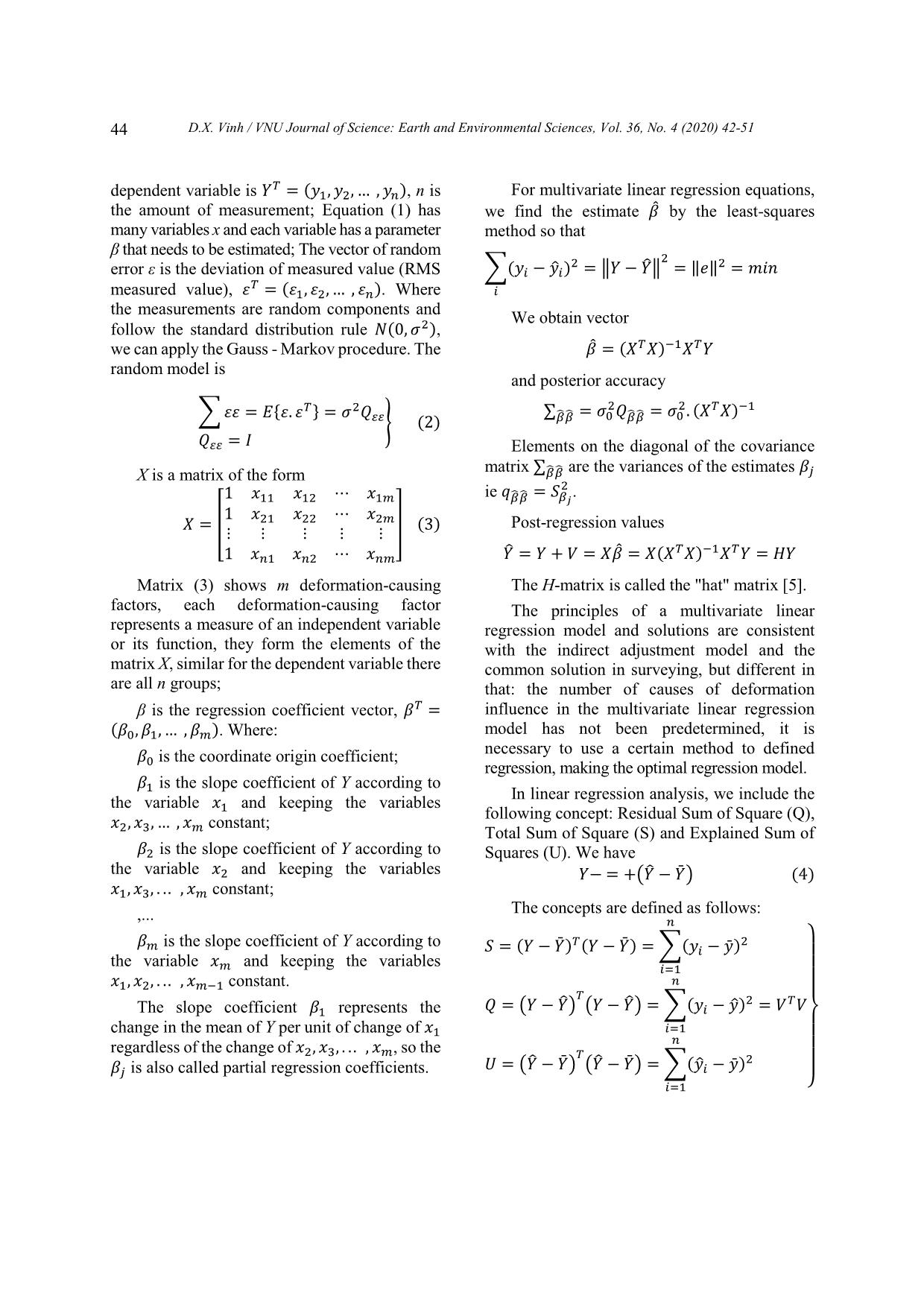
Trang 3
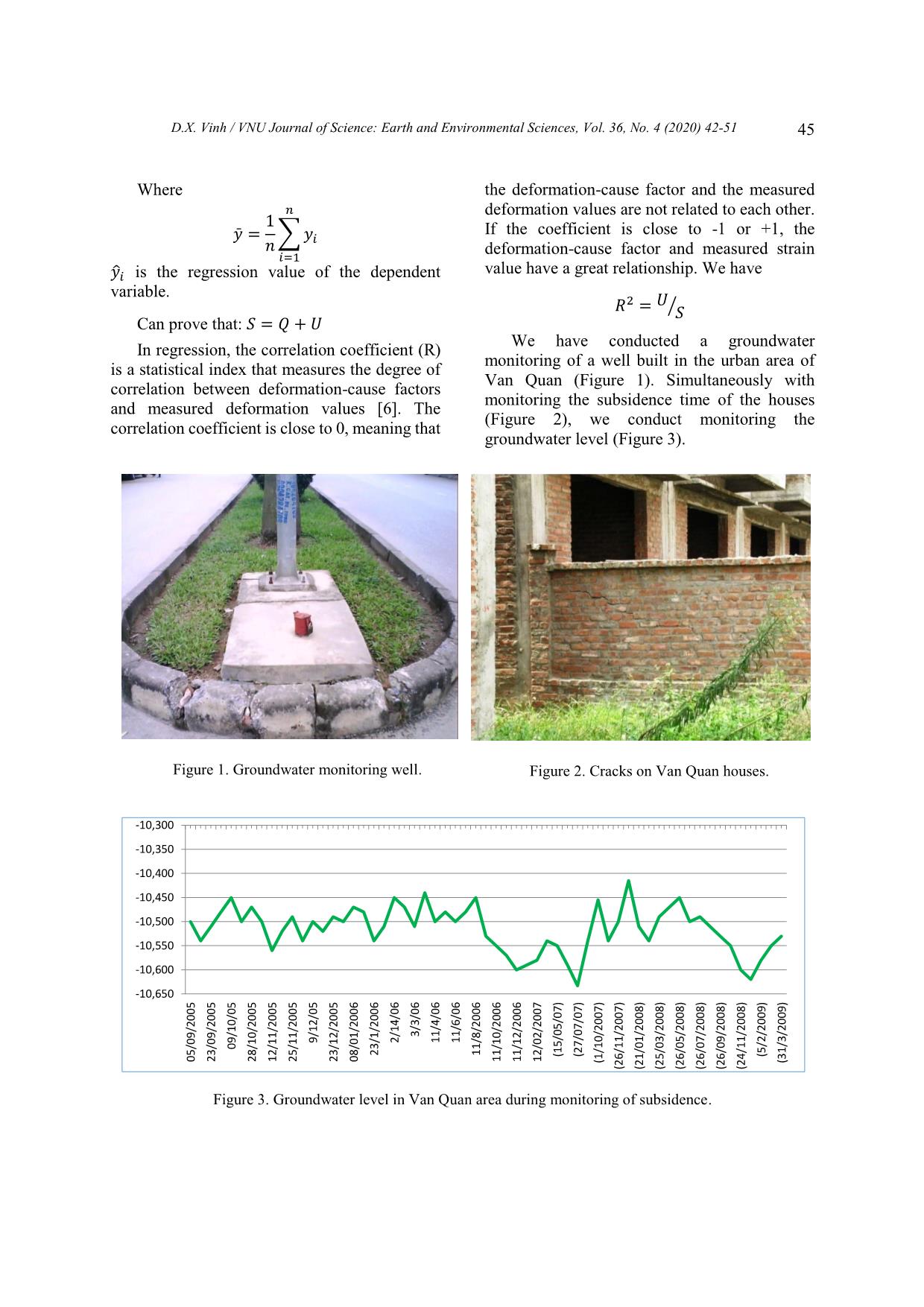
Trang 4
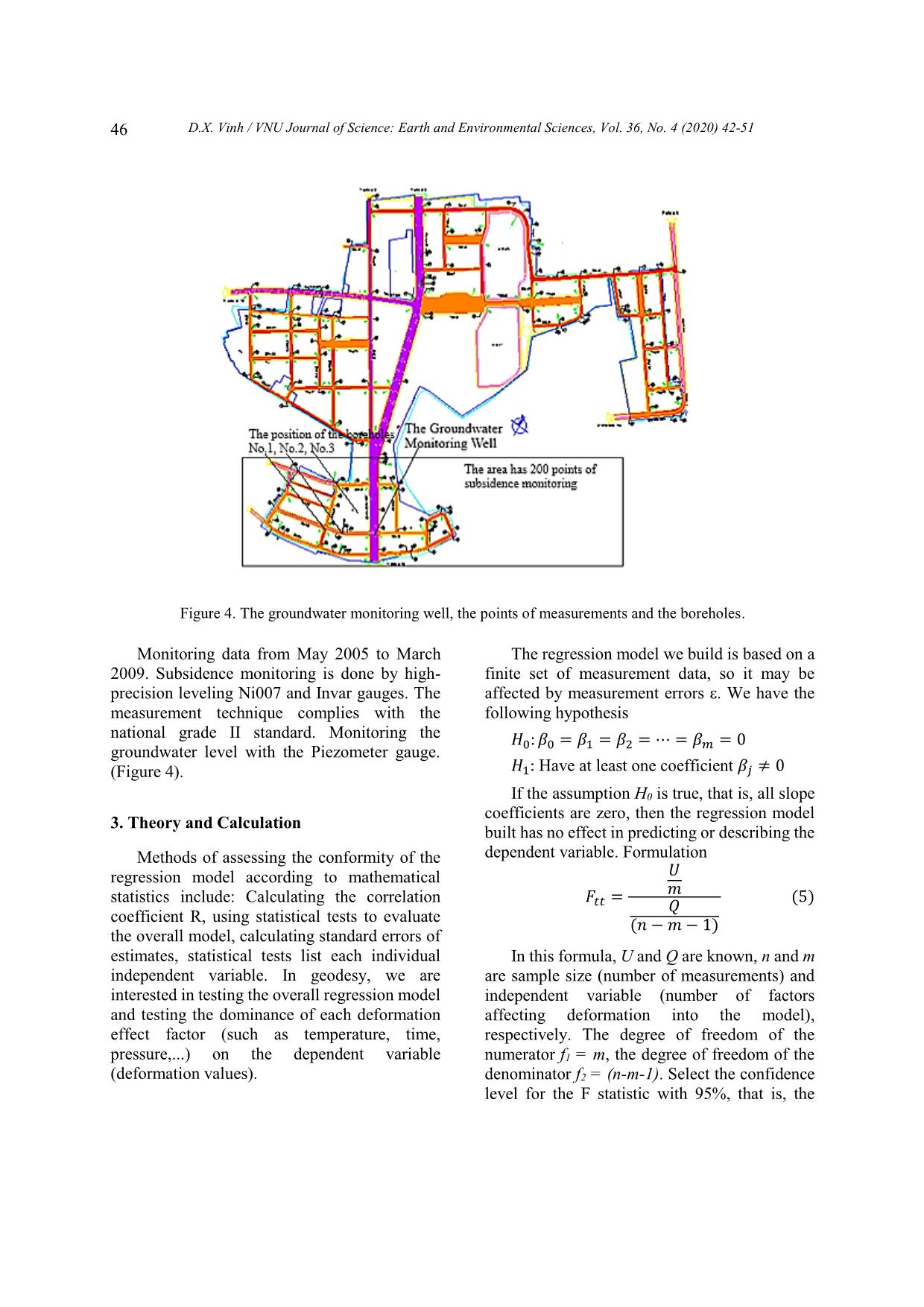
Trang 5
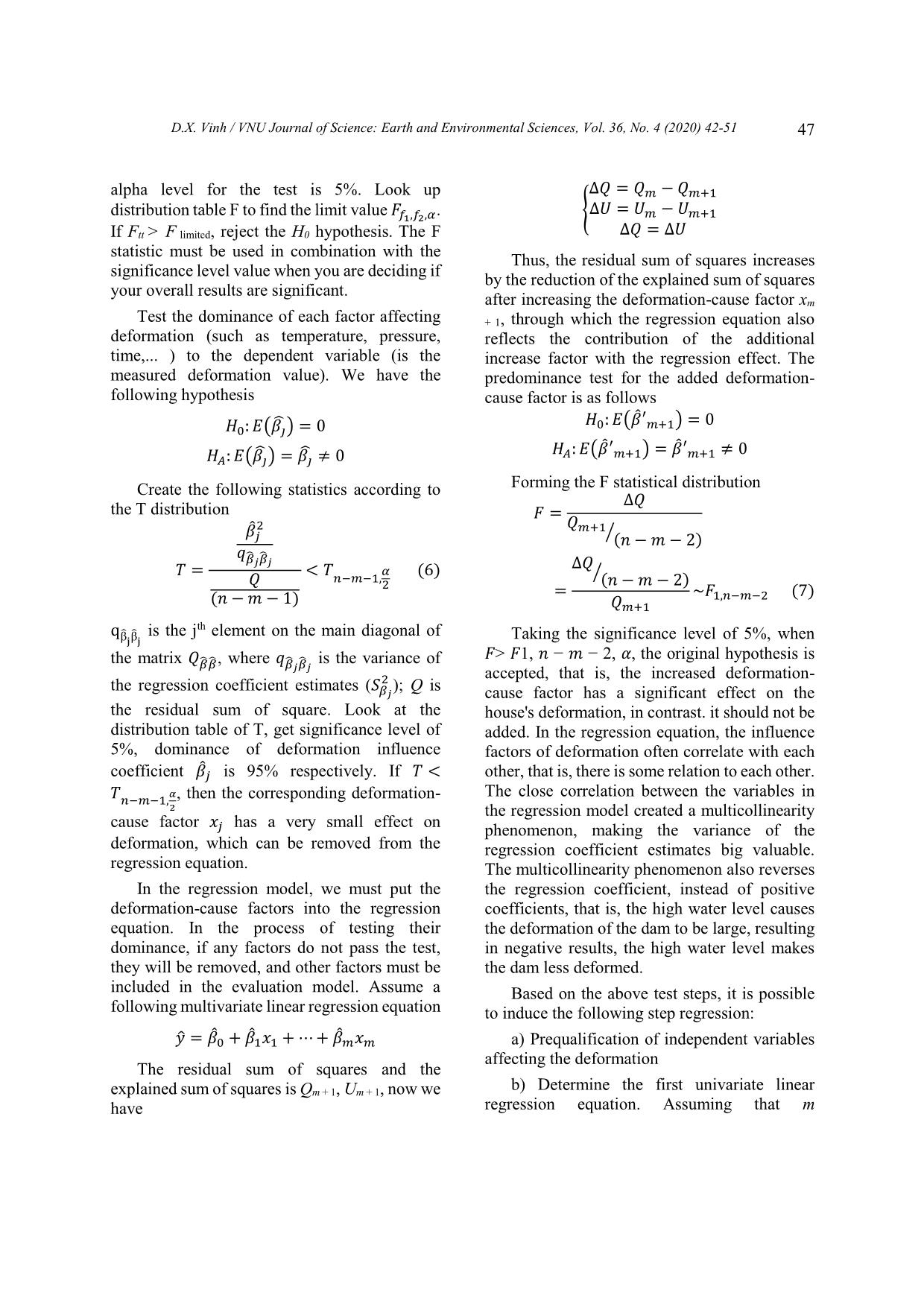
Trang 6
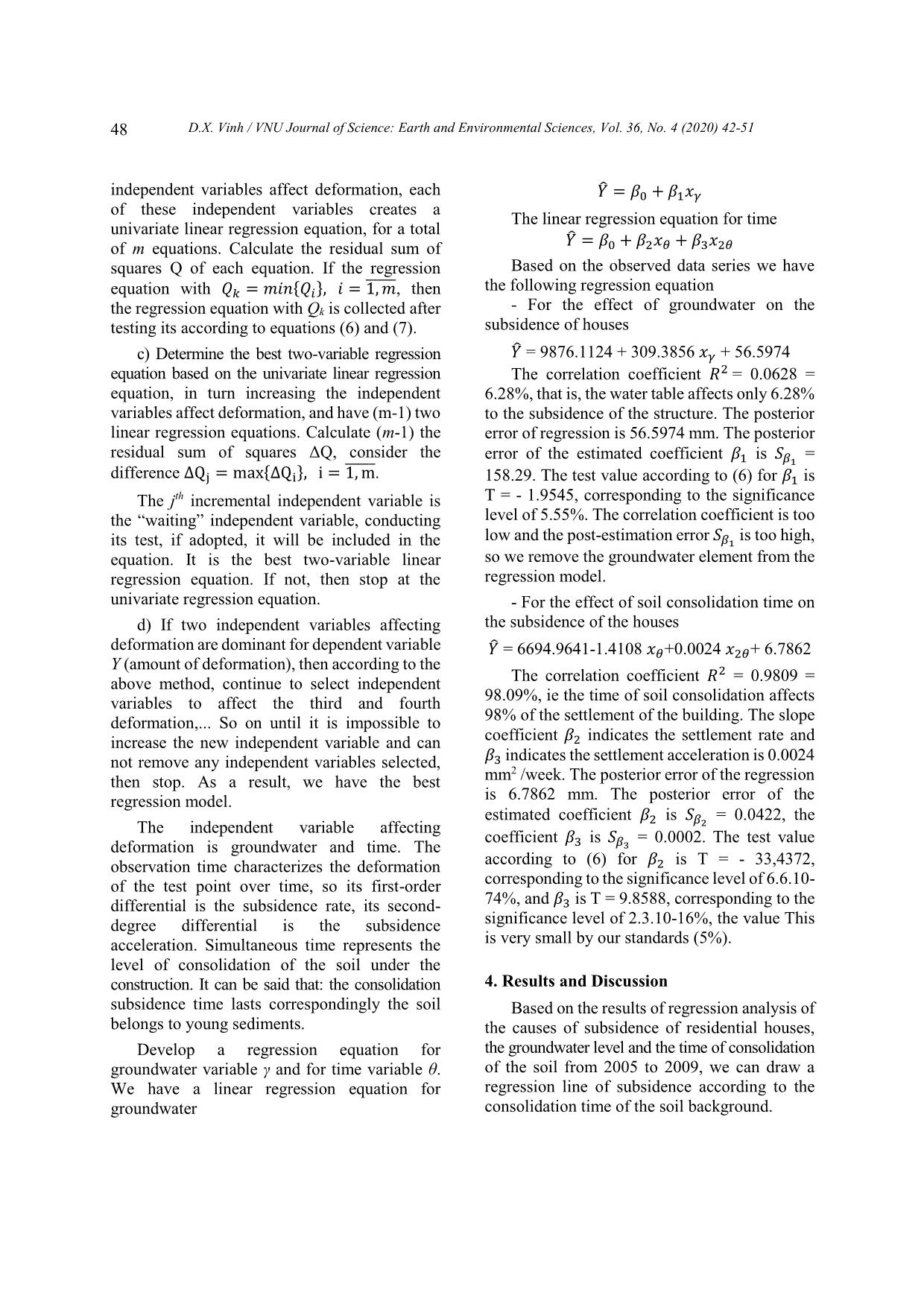
Trang 7
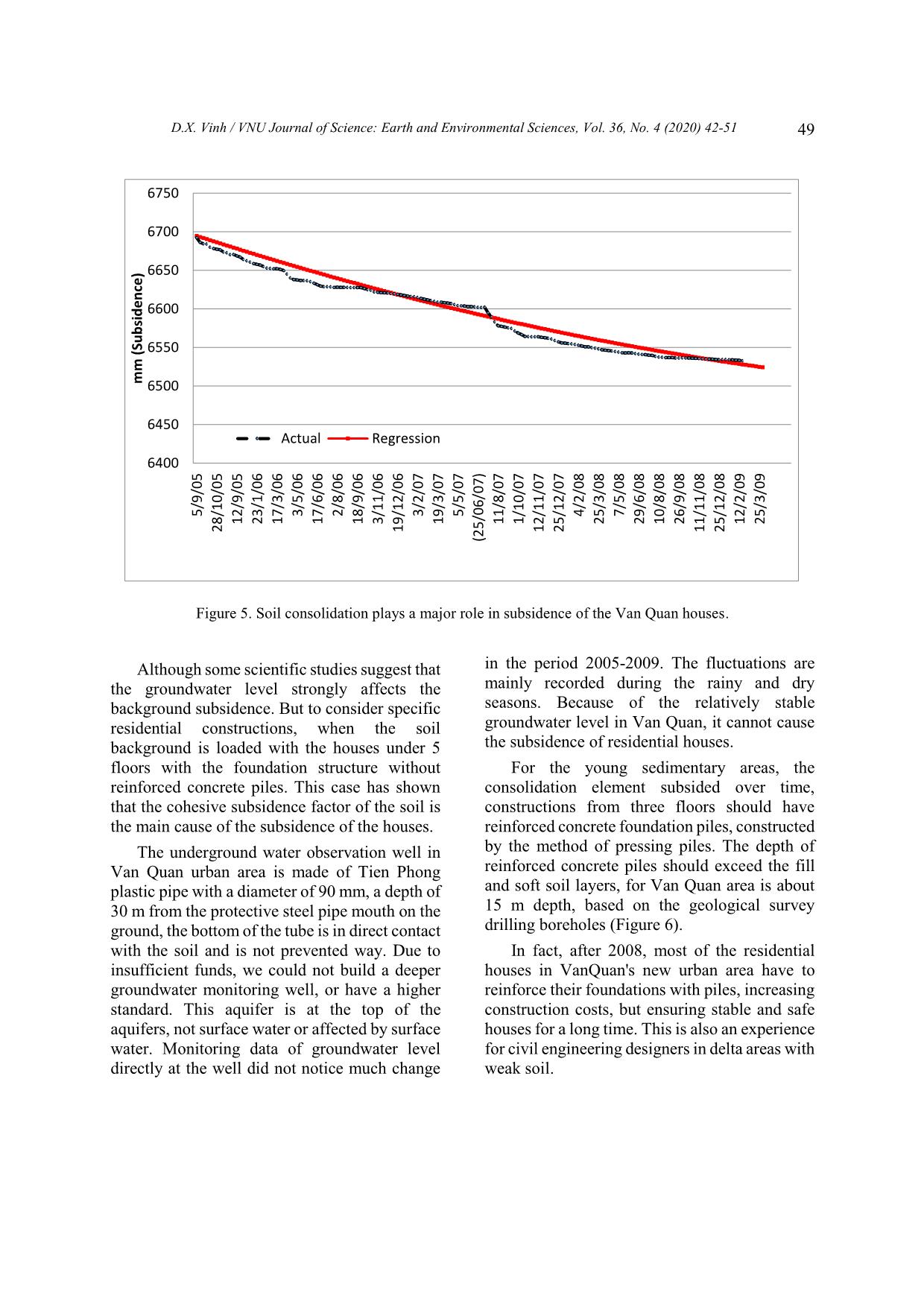
Trang 8
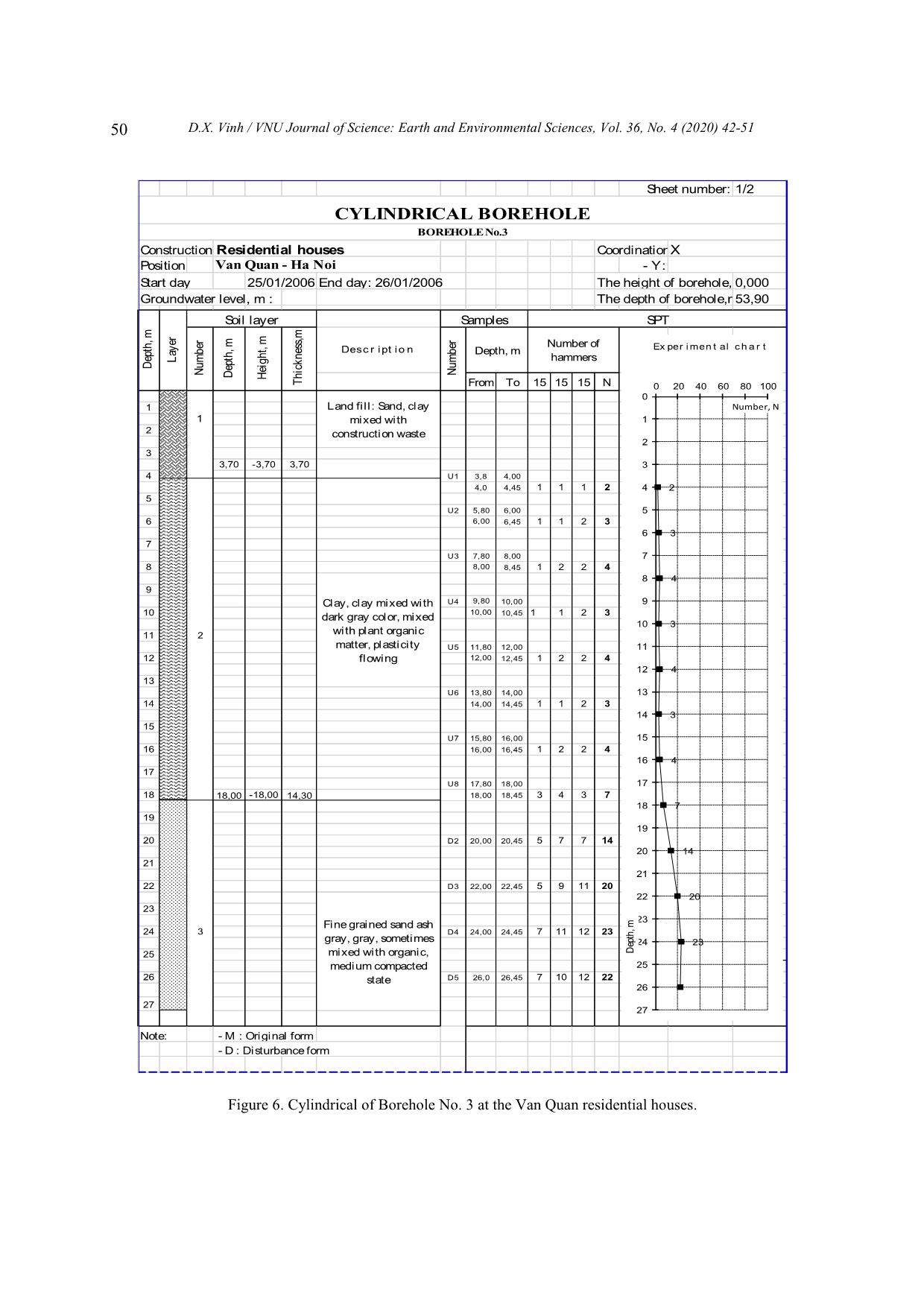
Trang 9
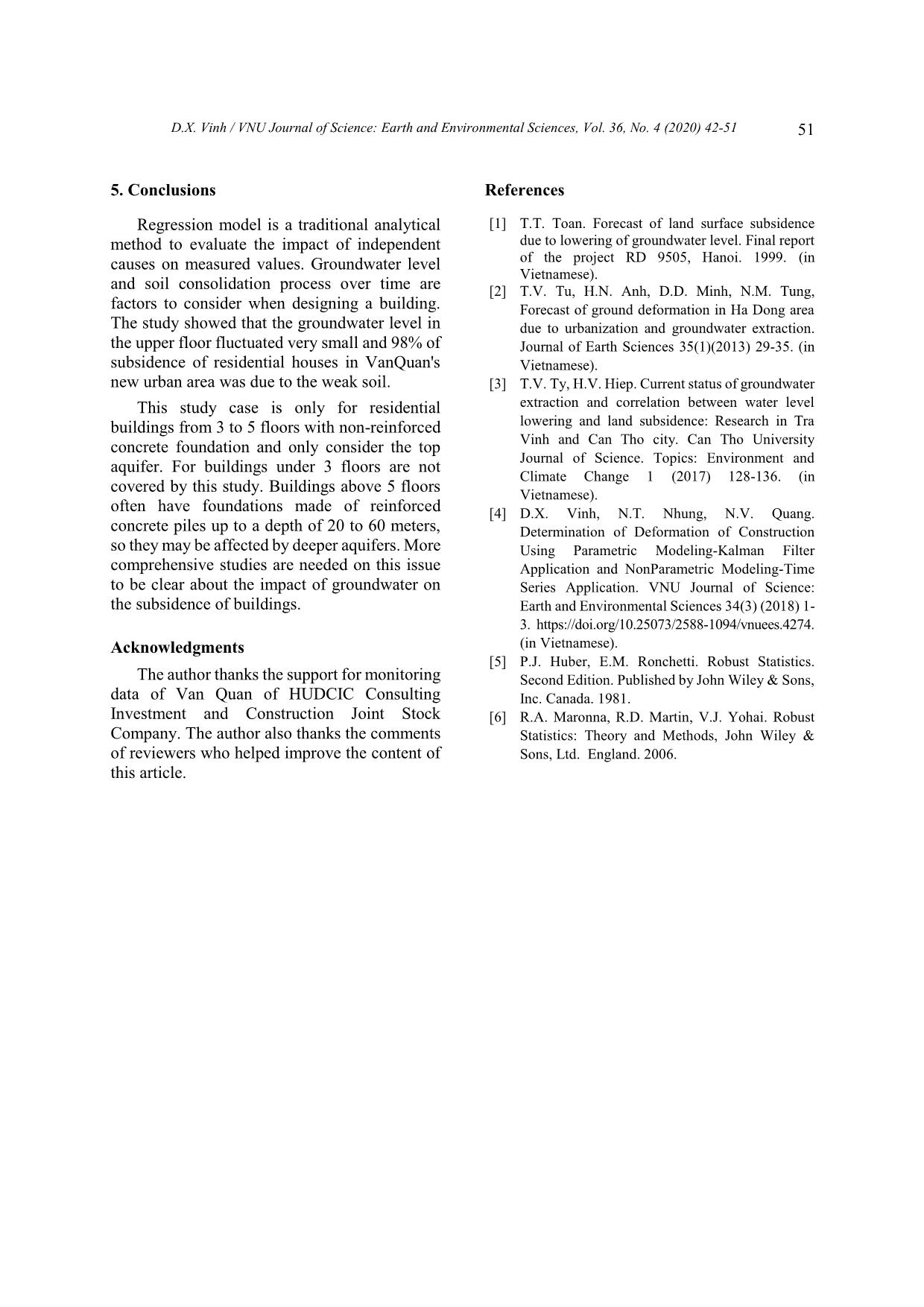
Trang 10
Tóm tắt nội dung tài liệu: On the Influence of the Soil and Groundwater to the Subsidence of Houses in Van Quan, Hanoi
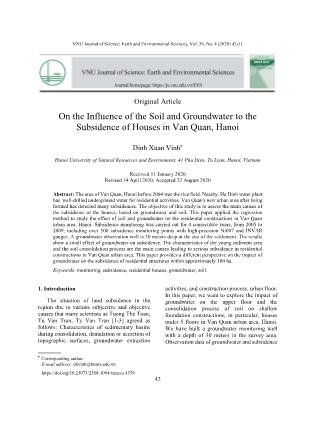
VNU Journal of Science: Earth and Environmental Sciences, Vol. 36, No. 4 (2020) 42-51
42
Original Article
On the Influence of the Soil and Groundwater to the
Subsidence of Houses in Van Quan, Hanoi
Dinh Xuan Vinh
Hanoi University of Natural Resources and Environment, 41 Phu Dien, Tu Liem, Hanoi, Vietnam
Received 11 January 2020
Revised 14 April 2020; Accepted 22 August 2020
Abstract: The area of Van Quan, Hanoi before 2004 was the rice field. Nearby, Ha Dinh water plant
has well-drilled underground water for residential activities. Van Quan's new urban area after being
formed has detected many subsidences. The objective of this study is to assess the main causes of
the subsidence of the houses, based on groundwater and soil. This paper applied the regression
method to study the effect of soil and groundwater on the residential constructions in Van Quan
urban area, Hanoi. Subsidence monitoring was carried out for 4 consecutive years, from 2005 to
2009, including over 500 subsidence monitoring points with high-precision Ni007 and INVAR
gauges. A groundwater observation well is 30 meters deep at the site of the settlement. The results
show a small effect of groundwater on subsidence. The characteristics of the young sediment area
and the soil consolidation process are the main causes leading to serious subsidence in residential
constructions in Van Quan urban area. This paper provides a different perspective on the impact of
groundwater on the subsidence of residential structures within approximately 100 ha.
Keywords: monitoring, subsidence, residential houses, groundwater, soil.
1. Introduction
The situation of land subsidence in the
region due to various subjective and objective
causes that many scientists as Tuong The Toan,
Tu Van Tran, Ty Van Tran [1-3] agreed as
follows: Characteristics of sedimentary basins
during consolidation, denudation or accretion of
topographic surfaces, groundwater extraction
________
Corresponding author.
E-mail address: dxvinh@hunre.edu.vn
https://doi.org/10.25073/2588-1094/vnuees.4539
activities, and construction process. urban floor.
In this paper, we want to explore the impact of
groundwater on the upper floor and the
consolidation process of soil on shallow
foundation constructions, in particular, houses
under 5 floors in Van Quan urban area, Hanoi.
We have built a groundwater monitoring well
with a depth of 30 meters in the survey area.
Observation data of groundwater and subsidence
D.X. Vinh / VNU Journal of Science: Earth and Environmental Sciences, Vol. 36, No. 4 (2020) 42-51 43
of residential houses of Van Quan urban area
were conducted regression analysis. Thereby we
assess the influence of each cause to the
settlement of the houses on the young
sedimentary basin.
Some studies use the method of Terzaghi as
Ty Van Tran, Hiep Van Huynh [3], or the Finite
Element method as Tu Van Tran et al [2], based
on groundwater monitoring data to forecast
ground subsidence. In this study, we use the
groundwater monitoring data in the subsidence
area (about 100 hectares) and the subsidence
monitoring data of the houses according to
national Class II leveling Regulation.
Conducting the regression analysis for each
cause of subsidence. The first is groundwater.
The second is the during consolidation
subsidence of the soil because Van Quan urban
area is located on a young sedimentary basin [2].
2. Research Methods and Data
The raw monitoring data including
appropriate measurements is a very important
part of the building safety data. Based on the
monitoring data, one can recheck the design plan
as well as the construction process and the
operation of the building. The raw data provide
valuable information that sheds light on the
stability of the building. However, the raw data
cannot reveal the shifting field or the
deformation trend of the building. A
comprehensive analysis is therefore needed to
accurately and comprehensively identify various
deformations from a large volume of raw data.
Two types of dynamic models are formulated to
analyze deformation monitoring test data, non-
parametric models based on mathematical-
statistical theory, and principles-based parametric
models major of continuous mechanics.
Non-parametric model based on
mathematical - statistical prediction algorithms.
The first model is based on a functional
relationship between the independent variables
(the environment variables) and the dependent
variables (are the deformations). Models of this
type can be interpreted as internal causes and
results within the system. This format includes
multiple regression (MR) model, stepwise
regression (SR), principal component regression
(PCR), partial least square regression (PLSR)
and artificial neural network (ANN). The second
model is based on the statistical rule of
dependent variables ie using linear statistical
models themselves, not by other environment
variables. They do not establish a model between
cause and effect. This type includes Time series
(TS series), Gray system (GS). The deformation
prediction model is based on information drawn
from the deformation monitoring data series,
these processes are performed in different ways.
Parameter model based on the analysis of
monitoring data by continuous mechanical rules.
First, determine the relationship between the
dependent variables and the independent
variables built on mechanical rules. Next, linear
statistics are applied to correct the assumed
calculation values or parameters throughout the
calculation. This model type has a Kalman filter
[4].
Regression analysis is a statistical method
where the expected value of one or more random
variables is predicted based on the condition of
other (calculated) random variables. Regression
analysis is not just about curve match ...
(𝑛 −𝑚 − 1)
< 𝑇
𝑛−𝑚−1,
𝛼
2
(6)
qβ̂jβ̂j
is the jth element on the main diagonal of
the matrix 𝑄�̂��̂�, where 𝑞�̂�𝑗�̂�𝑗 is the variance of
the regression coefficient estimates (𝑆𝛽𝑗
2 ); Q is
the residual sum of square. Look at the
distribution table of T, get significance level of
5%, dominance of deformation influence
coefficient �̂�𝑗 is 95% respectively. If 𝑇 <
𝑇𝑛−𝑚−1,𝛼
2
, then the corresponding deformation-
cause factor 𝑥𝑗 has a very small effect on
deformation, which can be removed from the
regression equation.
In the regression model, we must put the
deformation-cause factors into the regression
equation. In the process of testing their
dominance, if any factors do not pass the test,
they will be removed, and other factors must be
included in the evaluation model. Assume a
following multivariate linear regression equation
�̂� = �̂�0 + �̂�1𝑥1 +⋯+ �̂�𝑚𝑥𝑚
The residual sum of squares and the
explained sum of squares is Qm + 1, Um + 1, now we
have
{
∆𝑄 = 𝑄𝑚 −𝑄𝑚+1
∆𝑈 = 𝑈𝑚 − 𝑈𝑚+1
∆𝑄 = ∆𝑈
Thus, the residual sum of squares increases
by the reduction of the explained sum of squares
after increasing the deformation-cause factor xm
+ 1, through which the regression equation also
reflects the contribution of the additional
increase factor with the regression effect. The
predominance test for the added deformation-
cause factor is as follows
𝐻0: 𝐸(�̂�′𝑚+1) = 0
𝐻𝐴: 𝐸(�̂�′𝑚+1) = �̂�′𝑚+1 ≠ 0
Forming the F statistical distribution
𝐹 =
∆𝑄
𝑄𝑚+1
(𝑛 − 𝑚 − 2)⁄
=
∆𝑄
(𝑛 −𝑚 − 2)⁄
𝑄𝑚+1
~𝐹1,𝑛−𝑚−2 (7)
Taking the significance level of 5%, when
𝐹> 𝐹1, 𝑛 − 𝑚 − 2, 𝛼, the original hypothesis is
accepted, that is, the increased deformation-
cause factor has a significant effect on the
house's deformation, in contrast. it should not be
added. In the regression equation, the influence
factors of deformation often correlate with each
other, that is, there is some relation to each other.
The close correlation between the variables in
the regression model created a multicollinearity
phenomenon, making the variance of the
regression coefficient estimates big valuable.
The multicollinearity phenomenon also reverses
the regression coefficient, instead of positive
coefficients, that is, the high water level causes
the deformation of the dam to be large, resulting
in negative results, the high water level makes
the dam less deformed.
Based on the above test steps, it is possible
to induce the following step regression:
a) Prequalification of independent variables
affecting the deformation
b) Determine the first univariate linear
regression equation. Assuming that m
D.X. Vinh / VNU Journal of Science: Earth and Environmental Sciences, Vol. 36, No. 4 (2020) 42-51 48
independent variables affect deformation, each
of these independent variables creates a
univariate linear regression equation, for a total
of m equations. Calculate the residual sum of
squares Q of each equation. If the regression
equation with 𝑄𝑘 = 𝑚𝑖𝑛{𝑄𝑖}, 𝑖 = 1,𝑚̅̅ ̅̅ ̅̅ , then
the regression equation with Qk is collected after
testing its according to equations (6) and (7).
c) Determine the best two-variable regression
equation based on the univariate linear regression
equation, in turn increasing the independent
variables affect deformation, and have (m-1) two
linear regression equations. Calculate (m-1) the
residual sum of squares ΔQ, consider the
difference ∆Qj = max{∆Qi}, i = 1,m̅̅ ̅̅ ̅.
The jth incremental independent variable is
the “waiting” independent variable, conducting
its test, if adopted, it will be included in the
equation. It is the best two-variable linear
regression equation. If not, then stop at the
univariate regression equation.
d) If two independent variables affecting
deformation are dominant for dependent variable
Y (amount of deformation), then according to the
above method, continue to select independent
variables to affect the third and fourth
deformation,... So on until it is impossible to
increase the new independent variable and can
not remove any independent variables selected,
then stop. As a result, we have the best
regression model.
The independent variable affecting
deformation is groundwater and time. The
observation time characterizes the deformation
of the test point over time, so its first-order
differential is the subsidence rate, its second-
degree differential is the subsidence
acceleration. Simultaneous time represents the
level of consolidation of the soil under the
construction. It can be said that: the consolidation
subsidence time lasts correspondingly the soil
belongs to young sediments.
Develop a regression equation for
groundwater variable γ and for time variable θ.
We have a linear regression equation for
groundwater
�̂� = 𝛽0 + 𝛽1𝑥𝛾
The linear regression equation for time
�̂� = 𝛽0 + 𝛽2𝑥𝜃 + 𝛽3𝑥2𝜃
Based on the observed data series we have
the following regression equation
- For the effect of groundwater on the
subsidence of houses
�̂� = 9876.1124 + 309.3856 𝑥𝛾 + 56.5974
The correlation coefficient 𝑅2 = 0.0628 =
6.28%, that is, the water table affects only 6.28%
to the subsidence of the structure. The posterior
error of regression is 56.5974 mm. The posterior
error of the estimated coefficient 𝛽1 is 𝑆𝛽1 =
158.29. The test value according to (6) for 𝛽1 is
T = - 1.9545, corresponding to the significance
level of 5.55%. The correlation coefficient is too
low and the post-estimation error 𝑆𝛽1 is too high,
so we remove the groundwater element from the
regression model.
- For the effect of soil consolidation time on
the subsidence of the houses
�̂� = 6694.9641-1.4108 𝑥𝜃+0.0024 𝑥2𝜃+ 6.7862
The correlation coefficient 𝑅2 = 0.9809 =
98.09%, ie the time of soil consolidation affects
98% of the settlement of the building. The slope
coefficient 𝛽2 indicates the settlement rate and
𝛽3 indicates the settlement acceleration is 0.0024
mm2 /week. The posterior error of the regression
is 6.7862 mm. The posterior error of the
estimated coefficient 𝛽2 is 𝑆𝛽2 = 0.0422, the
coefficient 𝛽3 is 𝑆𝛽3 = 0.0002. The test value
according to (6) for 𝛽2 is T = - 33,4372,
corresponding to the significance level of 6.6.10-
74%, and 𝛽3 is T = 9.8588, corresponding to the
significance level of 2.3.10-16%, the value This
is very small by our standards (5%).
4. Results and Discussion
Based on the results of regression analysis of
the causes of subsidence of residential houses,
the groundwater level and the time of consolidation
of the soil from 2005 to 2009, we can draw a
regression line of subsidence according to the
consolidation time of the soil background.
D.X. Vinh / VNU Journal of Science: Earth and Environmental Sciences, Vol. 36, No. 4 (2020) 42-51 49
Figure 5. Soil consolidation plays a major role in subsidence of the Van Quan houses.
Although some scientific studies suggest that
the groundwater level strongly affects the
background subsidence. But to consider specific
residential constructions, when the soil
background is loaded with the houses under 5
floors with the foundation structure without
reinforced concrete piles. This case has shown
that the cohesive subsidence factor of the soil is
the main cause of the subsidence of the houses.
The underground water observation well in
Van Quan urban area is made of Tien Phong
plastic pipe with a diameter of 90 mm, a depth of
30 m from the protective steel pipe mouth on the
ground, the bottom of the tube is in direct contact
with the soil and is not prevented way. Due to
insufficient funds, we could not build a deeper
groundwater monitoring well, or have a higher
standard. This aquifer is at the top of the
aquifers, not surface water or affected by surface
water. Monitoring data of groundwater level
directly at the well did not notice much change
in the period 2005-2009. The fluctuations are
mainly recorded during the rainy and dry
seasons. Because of the relatively stable
groundwater level in Van Quan, it cannot cause
the subsidence of residential houses.
For the young sedimentary areas, the
consolidation element subsided over time,
constructions from three floors should have
reinforced concrete foundation piles, constructed
by the method of pressing piles. The depth of
reinforced concrete piles should exceed the fill
and soft soil layers, for Van Quan area is about
15 m depth, based on the geological survey
drilling boreholes (Figure 6).
In fact, after 2008, most of the residential
houses in VanQuan's new urban area have to
reinforce their foundations with piles, increasing
construction costs, but ensuring stable and safe
houses for a long time. This is also an experience
for civil engineering designers in delta areas with
weak soil.
6400
6450
6500
6550
6600
6650
6700
6750
5
/9
/0
5
2
8
/1
0
/0
5
1
2
/9
/0
5
2
3
/1
/0
6
1
7
/3
/0
6
3
/5
/0
6
1
7
/6
/0
6
2
/8
/0
6
1
8
/9
/0
6
3
/1
1
/0
6
1
9
/1
2
/0
6
3
/2
/0
7
1
9
/3
/0
7
5
/5
/0
7
(2
5
/0
6
/0
7
)
1
1
/8
/0
7
1
/1
0
/0
7
1
2
/1
1
/0
7
2
5
/1
2
/0
7
4
/2
/0
8
2
5
/3
/0
8
7
/5
/0
8
2
9
/6
/0
8
1
0
/8
/0
8
2
6
/9
/0
8
1
1
/1
1
/0
8
2
5
/1
2
/0
8
1
2
/2
/0
9
2
5
/3
/0
9
m
m
(
Su
b
si
d
e
n
ce
)
Actual Regression
D.X. Vinh / VNU Journal of Science: Earth and Environmental Sciences, Vol. 36, No. 4 (2020) 42-51 50
Figure 6. Cylindrical of Borehole No. 3 at the Van Quan residential houses.
Sheet number: 1/2
BOREHOLE No.3
Construction Residential houses Coordination:
Position Van Quan - Ha Noi - Y:
Start day 25/01/2006 End day: 26/01/2006 The height of borehole,m:0,000
Groundwater level, m : The depth of borehole,m:53,90
Soil layer Samples SPT
Desc r ipt io n
`
From To 15 15 15 N
1
1
2
3
3,70 -3,70 3,70
4 U1 3,8 4,00
4,0 4,45 1 1 1 2
5
U2 5,80 6,00
6 6,00 6,45 1 1 2 3
7
U3 7,80 8,00
8 8,00 8,45 1 2 2 4
9
U4 9,80 10,00
10 10,00 10,45 1 1 2 3
11 2
U5 11,80 12,00
12 12,00 12,45 1 2 2 4
13
U6 13,80 14,00
14 14,00 14,45 1 1 2 3
15
U7 15,80 16,00
16 16,00 16,45 1 2 2 4
17
U8 17,80 18,00
18 18,00 -18,00 14,30 18,00 18,45 3 4 3 7
19
20 D2 20,00 20,45 5 7 7 14
21
22 D3 22,00 22,45 5 9 11 20
23
24 3 D4 24,00 24,45 7 11 12 23
25
26 D5 26,0 26,45 7 10 12 22
27
Note: - M : Original form
- D : Disturbance form
Fine grained sand ash
gray, gray, sometimes
mixed with organic,
medium compacted
state
H
ei
gh
t,
m
T
hi
ck
ne
ss
,m
N
um
be
r
Depth, m
Clay, clay mixed with
dark gray color, mixed
with plant organic
matter, plasticity
flowing
Land fi l l : Sand, clay
mixed with
construction waste
CYLINDRICAL BOREHOLE
D
ep
th
, m
L
ay
er
N
um
be
r
D
ep
th
, m
X
Number of
hammers
2
3
4
3
4
3
4
7
14
20
23
0
1
2
3
4
5
6
7
8
9
10
11
12
13
14
15
16
17
18
19
20
21
22
23
24
25
26
27
0 20 40 60 80 100
Ex per i men t al ch a r t
Number, N
D
ep
th
, m
D.X. Vinh / VNU Journal of Science: Earth and Environmental Sciences, Vol. 36, No. 4 (2020) 42-51 51
5. Conclusions
Regression model is a traditional analytical
method to evaluate the impact of independent
causes on measured values. Groundwater level
and soil consolidation process over time are
factors to consider when designing a building.
The study showed that the groundwater level in
the upper floor fluctuated very small and 98% of
subsidence of residential houses in VanQuan's
new urban area was due to the weak soil.
This study case is only for residential
buildings from 3 to 5 floors with non-reinforced
concrete foundation and only consider the top
aquifer. For buildings under 3 floors are not
covered by this study. Buildings above 5 floors
often have foundations made of reinforced
concrete piles up to a depth of 20 to 60 meters,
so they may be affected by deeper aquifers. More
comprehensive studies are needed on this issue
to be clear about the impact of groundwater on
the subsidence of buildings.
Acknowledgments
The author thanks the support for monitoring
data of Van Quan of HUDCIC Consulting
Investment and Construction Joint Stock
Company. The author also thanks the comments
of reviewers who helped improve the content of
this article.
References
[1] T.T. Toan. Forecast of land surface subsidence
due to lowering of groundwater level. Final report
of the project RD 9505, Hanoi. 1999. (in
Vietnamese).
[2] T.V. Tu, H.N. Anh, D.D. Minh, N.M. Tung,
Forecast of ground deformation in Ha Dong area
due to urbanization and groundwater extraction.
Journal of Earth Sciences 35(1)(2013) 29-35. (in
Vietnamese).
[3] T.V. Ty, H.V. Hiep. Current status of groundwater
extraction and correlation between water level
lowering and land subsidence: Research in Tra
Vinh and Can Tho city. Can Tho University
Journal of Science. Topics: Environment and
Climate Change 1 (2017) 128-136. (in
Vietnamese).
[4] D.X. Vinh, N.T. Nhung, N.V. Quang.
Determination of Deformation of Construction
Using Parametric Modeling-Kalman Filter
Application and NonParametric Modeling-Time
Series Application. VNU Journal of Science:
Earth and Environmental Sciences 34(3) (2018) 1-
3. https://doi.org/10.25073/2588-1094/vnuees.4274.
(in Vietnamese).
[5] P.J. Huber, E.M. Ronchetti. Robust Statistics.
Second Edition. Published by John Wiley & Sons,
Inc. Canada. 1981.
[6] R.A. Maronna, R.D. Martin, V.J. Yohai. Robust
Statistics: Theory and Methods, John Wiley &
Sons, Ltd. England. 2006.
File đính kèm:
 on_the_influence_of_the_soil_and_groundwater_to_the_subsiden.pdf
on_the_influence_of_the_soil_and_groundwater_to_the_subsiden.pdf

